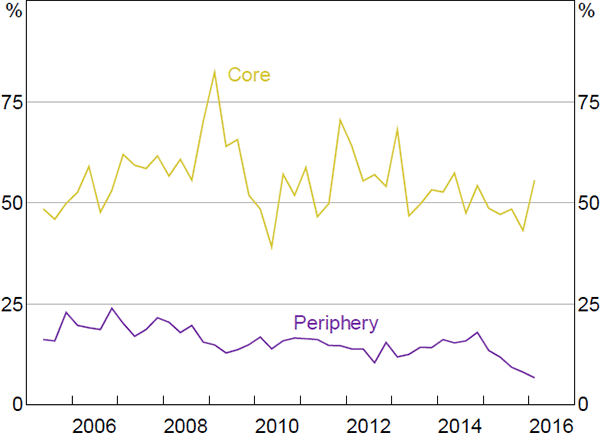RDP 2018-01: A Density-based Estimator of Core/Periphery Network Structures: Analysing the Australian Interbank Market Appendix F: Evidence of Intermediation
February 2018
- Download the Paper 1,628KB
In the core/periphery model proposed by Craig and von Peter (2014), one of the key features of the core is that they intermediate the lending/borrowing of the periphery banks. In the ideal core/periphery structure, this intermediation results in the core banks having both lending and borrowing links with the periphery. However, while observing such links is a necessary condition for this ideal intermediation, it is not sufficient, especially with low-frequency networks.
For example, suppose we split the network into large and small banks. By virtue of their size, the large banks may have relationships with many small banks. On some days, a given large bank may have a surplus of funds while some small banks have a deficit; so this large bank may lend to the small banks. On other days, the reverse may occur, causing the large bank to borrow from several small banks. When aggregated to a quarterly frequency, this behaviour would be observationally equivalent to intermediation. Moreover, if the small banks only had relationships with the large banks, and the large banks also borrowed from/lent to each other, the quarterly networks would resemble a core/periphery structure.
Even though the large banks are not intermediating in this example – since they are only lending/borrowing based on their own requirements – the fact that the small banks only deal with the large banks makes the large banks ‘core’ to the system. So one could argue that such a network still exhibits a core/periphery structure. That said, we want to present evidence that the core banks in our networks are actually intermediating.
To do this, we look at the share of days in which each bank both lends and borrows in the IBOC market (Figure F1). The average share is much higher for the core banks than it is for the periphery banks, supporting our claim that the core banks are intermediating in the IBOC market.
We note, however, that banks may also borrow and lend on the same day due to forecast errors.[35] If the distribution of forecast errors is symmetric, and banks have no tolerance for forecast errors, we would expect both core and periphery banks to exhibit a share of 50 per cent in Figure F1. Therefore, the difference between the core and periphery banks could just be due to differing tolerances for forecast errors.[36]
That said, Hing, Kelly and Olivan (2016, p 37) state that ‘most banks wait until they are reasonably certain of their liquidity position … before transacting in the cash [IBOC] market’. And, over the sample period, the average shares for each of the major banks (as these banks are almost always in the core) are statistically higher than 50 per cent (at the 1 per cent level). So they likely represent more than just forecast errors.

Note: Simple average of banks' quarterly share
Footnotes
Banks' need for the IBOC market arises from the tens of thousands of payments that flow between banks on a daily basis. Any error in forecasting these flows could result in a bank lending (borrowing) too much, requiring them to borrow (lend) to offset their forecast error. [35]
For example, if the typical values of forecast errors for some banks are sufficiently small, it may be more profitable for these banks to maintain a small liquidity buffer than to retain sufficient staff for late-day re-entry into the IBOC market. [36]